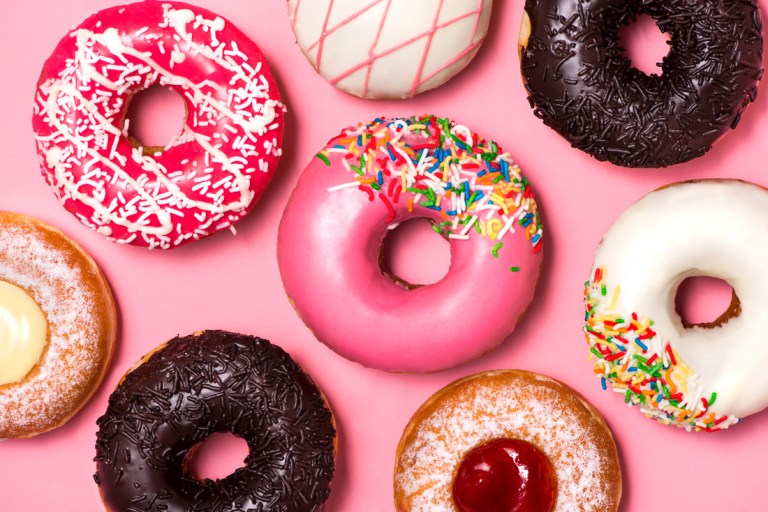How Dunkin’ Donuts And California Donuts Rolled The Dice (And The Dough)

Everybody loves donuts, and that’s why America decided it needed to have a National Donut Day. But there’s more than one way to roll a donut, from the classic Dunkin’ Donuts Munchkin to the trendy and Instagrammable California Donuts Panda.
Whether you’re Dunkin’ Donuts, selling two billion donuts annually across 12,000 locations worldwide, or California Donuts, a single-location former franchise that has shaped itself into a Los Angeles legend, it’s a safe bet that you’ll find plenty of consumers ready to take a bite of what you have to offer.
Here’s how these two iconic donut brands found their niche.
California Donuts
Danette K’s California Donuts franchise location outlasted the sunset of the franchise itself. Danette purchased the business on Jan. 6, 1982, before the parent franchise shut down. Since then, her shop has developed its own identity over the decades.
There are other locations bearing the same name, but the ownership differs, said Danette, and so does the branding. No one else has the panda-themed donut that went viral across Instagram after Danette’s location shared it to its 439,000 followers.
Danette said she was just playing around when she came up with some of the shop’s earliest artistic creations that started to attract social media attention around six years ago. It was a complete accident, she said, that the business grew as big as it did – and the process happened slowly, not overnight.
At first, the 24-hour donut shop attracted the attention of food bloggers. Then, after making its way into media outlets like Delish and the L.A. Times, the general public followed suit. Finally, corporations hopped on the bandwagon, with mega-brands like Disney, Warner Brothers and Paramount partnering with the company to serve up themed donuts to coincide with major movie or media releases.
California Donuts has also done licensing with the Care Bears, said Danette. However, none of the Disney, Warner Brothers or Paramount partnerships have been fully licensed – those, she said, were just for fun, to help them get the word out about their latest project.
The business model is all about creating a product that’s visually pleasing, not something consumers would happily eat a dozen of, which distinguishes it from Dunkin’s classic Munchkin-branded donut holes. However, Danette said this hasn’t hurt the business in the slightest.
Although California Donuts is based in one of the most health-conscious areas of the country, Danette said even parents of young kids or diet-focused bodybuilders can justify one treat on a “cheat day.” Besides, she added, the establishment uses quality ingredients, which take a little of the guilt out of this pleasure.
Danette said her California Donuts location, iconic as it may be, has no plans to expand, because it’s a business priority to preserve the mom-and-pop feel and quality of the shop. To do that, she said, it’s important to maintain control over the product and experience, which becomes more difficult when further locations are added.
On National Donut Day, she predicts that the maple bacon donut and the iconic Panda donut will be among the shop’s top sellers.
Dunkin’ Donuts
Does America truly run on Dunkin’? Many customers sure do, as indicated by the sheer scale and continued growth of the company since opening its first location in Quincy, Massachusetts in 1950. Dunkin’ now serves donuts, coffee, egg sandwiches and more across 45 different countries.
Like Danette, Dunkin’ counts control over product and experience among its top priorities – and despite its size, CMO Tony Weisman said the company has been able to achieve the desired quality and consistency. Technology, he noted, has played a critical role in facilitating this.
Loyalty and mobile ordering, for instance, make the brand’s most frequent customers feel important and special, with promotions tailored individually. As a means of reducing friction, On-The-Go Mobile Ordering has grown substantially, with 70 percent of DD Perks rewards members continuing to use it after the initial trial phase.
Indeed, Weisman said Dunkin’ considers mobile ordering to be the future of how its guests will interact with the brand. It’s working to integrate with the Google Assistant on Apple and Android phones, and already lets customers order while driving through in-vehicle integrations with Chevrolet, Buick, GMC and Cadillac. It has also partnered with Waze to let the crowdsourced traffic platform’s users order ahead at the next Dunkin’ Donuts location on their route.
Weisman said continual innovation is among the company’s success strategies. That’s how it came up with its next-generation concept store in Quincy, Massachusetts, where customers can take the exclusive On-The-Go drive-thru lane to enjoy the most efficient experience – for DD Perks rewards members only.
Dunkin’ said it uses market research, trends analysis and sales data to evaluate and innovate menu items based on important factors like variety, sizes and flavors. The company said it’s important to empower consumer decision making by providing enough options for different types of consumers. That’s how Dunkin’ has successfully weathered Americans’ growing consciousness around living healthy lifestyles, said Weisman.
When serving so many markets, however, it’s not enough just to cater to individual preferences – a business must consider regional tastes as well. Weisman said Dunkin’s sour cream donut sells well in Chicago, while the peanut stick is always a hit in upstate New York. Customers in other markets may never have even heard of these products, he said.
Overseas, the offerings become even more varied, with Asian locations selling Pork Floss Donuts (yeast donuts topped with dried pork and dry seaweed, a savory treat) and Mochi Rings (made with glutinous rice).
So even though Dunkin’ Donuts has achieved a level of consistency across its 12,000 locations, Weisman said, distinguishing each store based on locational context and catering to each guest as an individual remain top priorities, even at such a large scale.